PocketGamer.biz has partnered up with US developer Pixelberry Studios to highlight its candid stories on the trials and triumphs of a startup game studio whose debut title High School Story stayed in the top grossing top 100 chart for a year.
This bi-weekly series of articles will provide a mix of drama, detailed learnings, and actual numbers from their experience launching and supporting a top game.
It isn’t a stretch to say that everyone at Pixelberry is interested in what our players think of our games.
We follow what they say on our Facebook pages for High School Story and Hollywood U, and at least once a day, someone will shout out something particularly funny that’s been spotted on tumblr.
Is it worth it?
Of all the posts we see from players, the most terrifying for the writing team is something that begins with: “Is it worth it?”
Usually this is a question that comes up when we release a quest that costs premium currency, which means players are either using their hard-earned currency or heading to the store to make a purchase so they have enough to buy the quest.
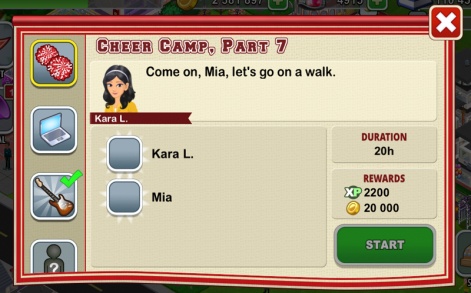
When you see a price tag of 100 diamonds, it’s easy to forget that it comes out to less than a dollar - it can cost around 51 cents if you purchase more of the premium currency at once.
Bigger bundles give bigger discounts on the premium currency.
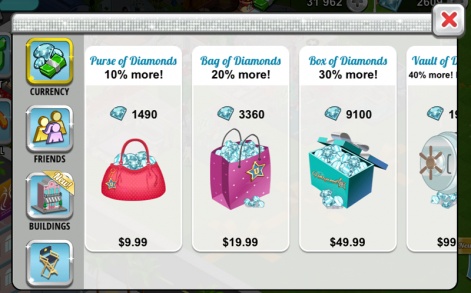
So is it worth it?
We think so, because we believe in the quality of the story that we're telling and because of all the passionate work that goes into creating it. We care about our characters - giving them realistic, complex, and intriguing personalities and histories.
We put a lot of heart into what we make, and because of that we also put a lot of time, creativity, energy, and work into it.
By the time a quest is released for players to see, at least five writers will have worked on it over the course of over three weeks
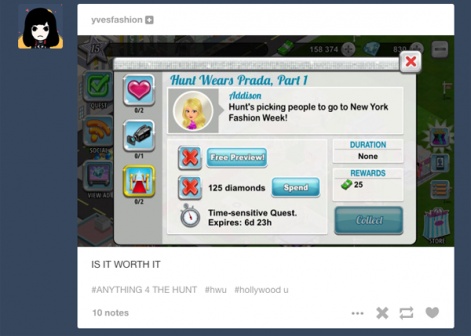
A quest is born
A quest begins with an idea. Maybe it’s a bigger plot that we’ve been planning for months, or maybe we see fans on our Facebook page or tumblr talking about a certain character they really want to date.
By brainstorming together, we make sure nothing gets overlooked and that the writer’s idea matches the tone and voice of the game.
In either case, a writer takes ownership of the idea and starts thinking about the best way to make it happen.
The second step is a brainstorm. Because we have limited office space, the brainstorm usually takes place outside. A group of four or five writers will take a walk for about an hour and discuss different ways of executing the idea, different problems that might come up, and in general just how to make it the best story possible.
Every writer has different blind spots and quirks - one has a tendency to make her characters too nice. Another sometimes tries to pack too much story into a single quest, and another is always trying to talk us into supernatural adventures (with varying degrees of success).
By brainstorming together, we make sure nothing gets overlooked and that the writer’s idea matches the tone and voice of the game.
The next step is an outline on a white board. This takes anywhere from one to three hours.
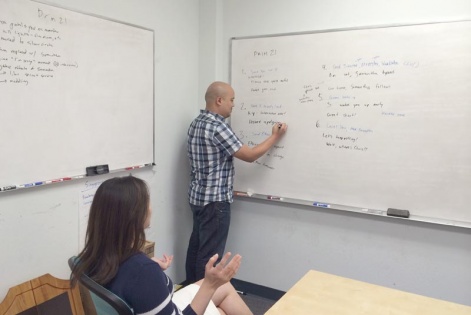
The writers sit in a room together and discuss the requirements for each part of the quest.
Most quests are around seven or eight parts long, and there are certain guidelines for what they need to be - and we always try to work in a relevant explanation in the quest for what’s going on, even if it means you have to buy a milkshake that costs 300,000 coins.
Next, the writer types up a detailed outline and shares this with the writing team. The outline might have questions for the team - like requesting ideas for catchphrases for a funny character, or things someone would eat at a fancy party. Notes come in, the outline is rewritten, and then the quest writing begins.
We put an incredible amount of heart into our writing.
After all of this pre-writing work, it takes a writer at least a week to write a date or quest.
This includes not just the creative writing, but also the coding that comes with inserting choices, flagging different branching paths, and creating custom dialogue that plays depending on a player’s chosen type or current relationship.
Making it perfect
Once the writer is done, the quest gets handed off into the pass pipeline. A first, high-level editorial pass is performed to review the content and give creative feedback.
Sometimes a quest just isn’t working and will need almost an entire rewrite. The writer takes between a day to three days to make the changes and then those changes are reviewed and approved.
A second pass comes next - usually these changes aren’t as big, although they’ll take a few hours to make. Then the quest’s economy is reviewed to make sure the rewards make sense and the timers are the right length. Then a final pass will be performed on the quest to catch any last errors, typos, and so on.
After the final pass, the quest leaves the writing team and moves to the QA team.
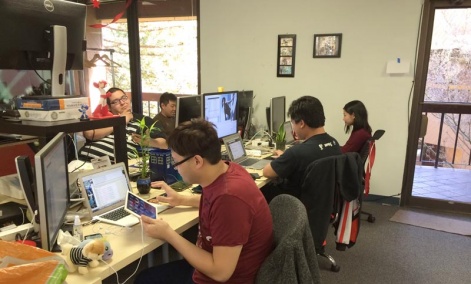
The quest is tested again for any lingering issues and every branch and possible path is played through. The QA team checks for consistency, crashes, and any other issues that would break a player’s game.
Finally, once those last changes are made, the quest is ready for release.
We put an incredible amount of heart into our writing, and all that being said, most quests in both High School Story and Hollywood U don’t require players to spend a single cent.
But for the players who do support us by spending their hard-earned money, we want to make sure they’re getting something on top of a game that’s already got so much in it.
Because those players are the ones who let us keep making the games we love so much - and they’re also the ones that let us keep offering so much of the game for free!
Kara Loo is the COO of Pixelberry Studios.
Through partnerships with non-profits, Pixelberry's hit game High School Story has taught millions of players about tough teen issues, like cyberbullying and eating disorders.
You can find out more at pixelberrystudios.com




















